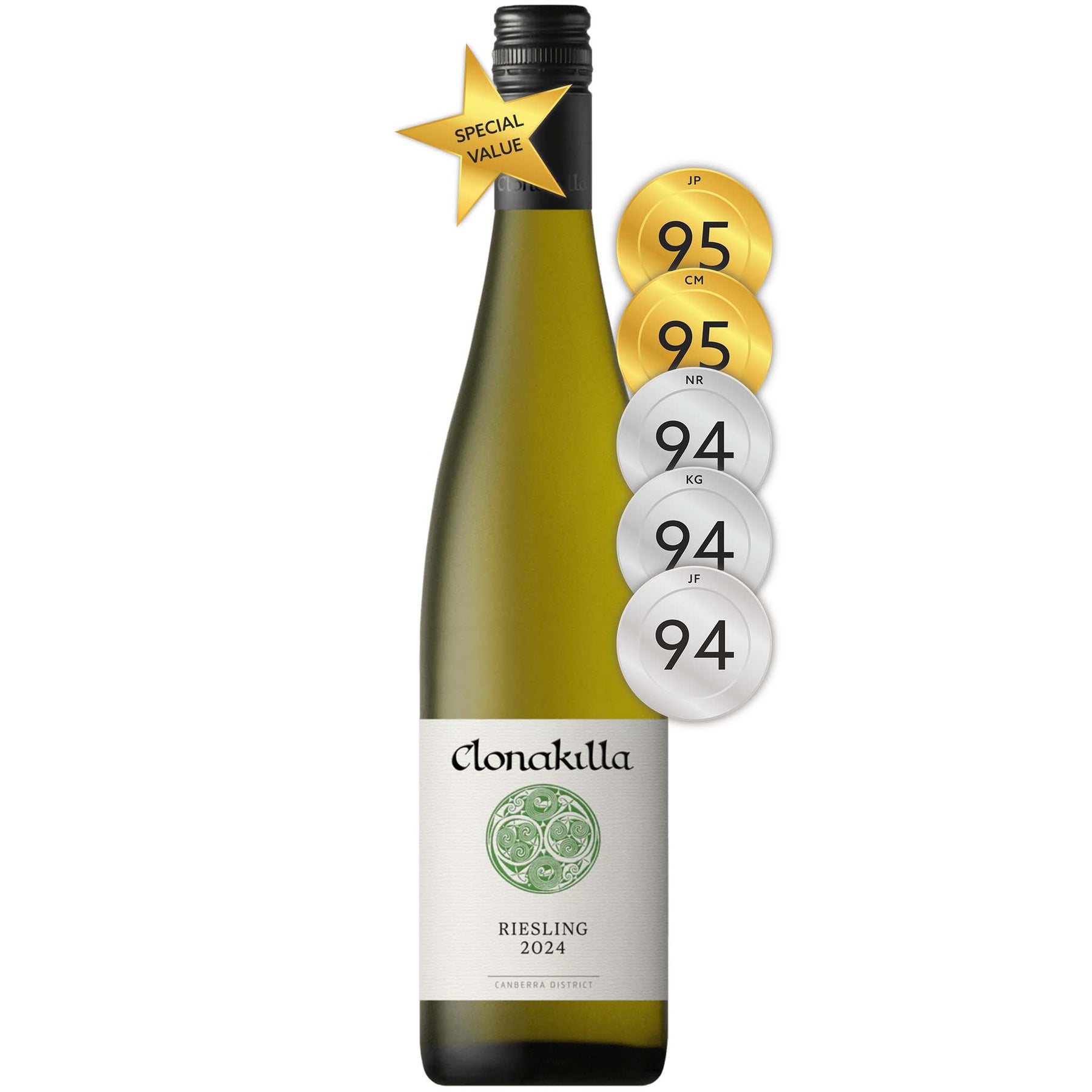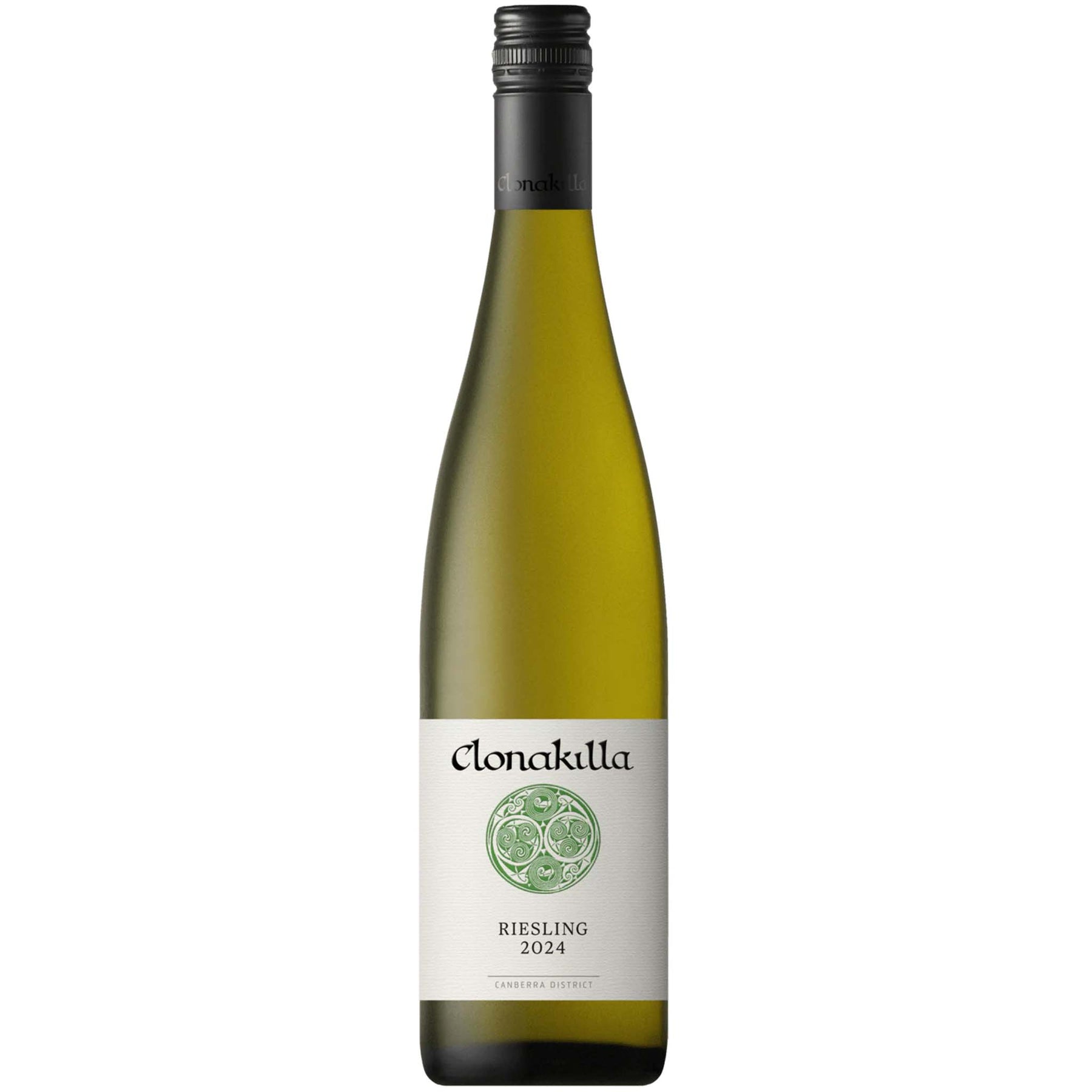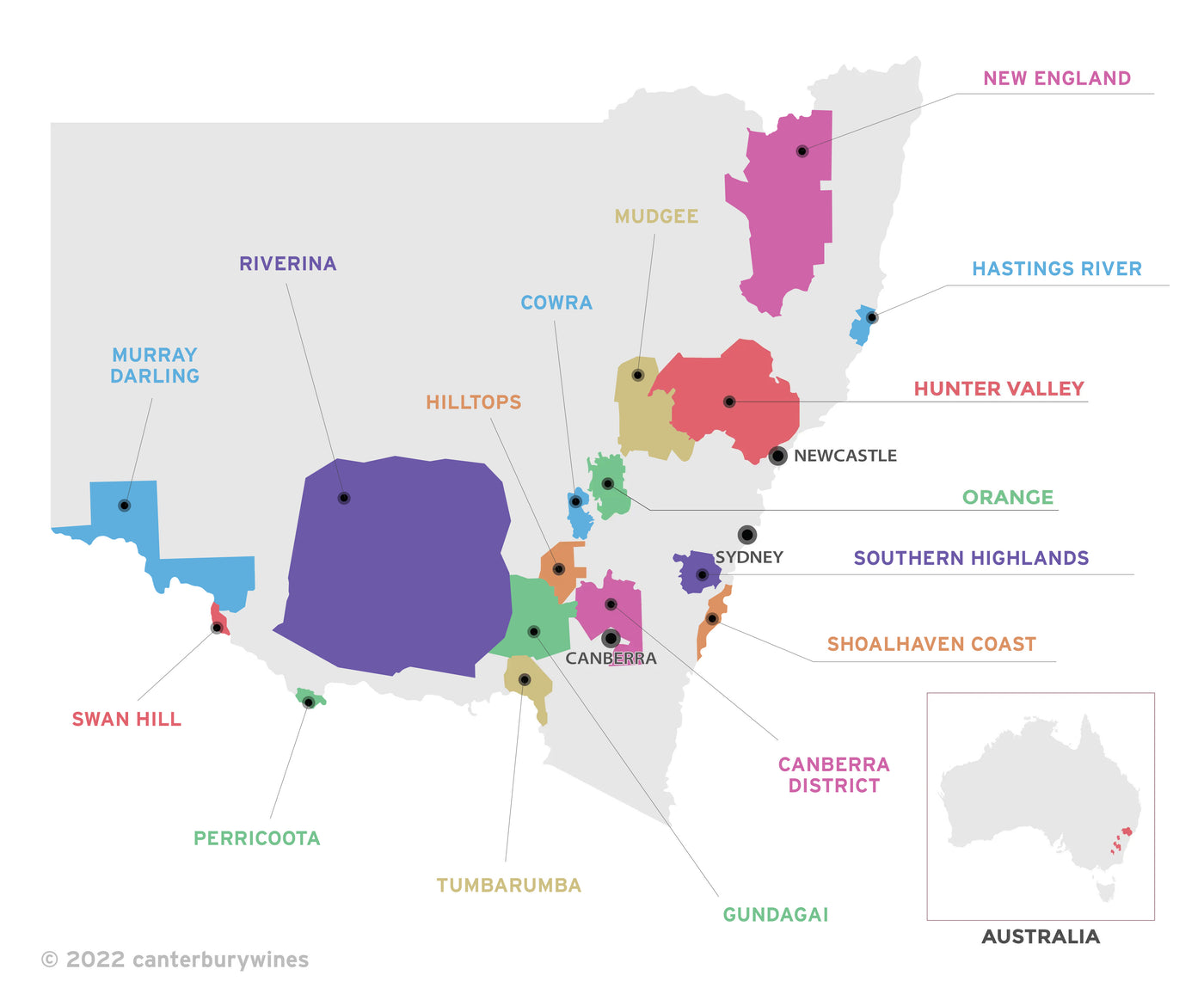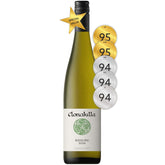

Clonakilla Riesling 2024
Style: White Wine
Closure: Screwcap
Clonakilla Riesling 2024
Warehouse
34 Redland Drive
Vermont VIC 3133
Australia
Critic Score: 95
Alcohol: 12.0%
Size: 750 ml
Drink by: 2045
Established in 1971, Clonakilla is a small family winery at Murrumbateman dedicated to producing distinctive, handcrafted Canberra region wines. They are famous for their world-class Shiraz Viognier, but their Riesling also sets the bar for this classic variety. Murrumbateman’s cool, continental climate and decomposed granite soils are perfectly suited to Riesling and the 2024 vintage was ideal - good spring rain, warm summer days, cool nights and a glorious early autumn. The grapes came in ripe and full of flavour and the wine has bright citrus fruit and river pebble freshness in abundance.
"One sniff and you’re hooked on the prettiness of it all, the citrus blossom scents, the wildflowers mingling with bright citrus notes of lemon and lime. Clonakilla ‘24 Riesling is so fine and gentle, almost delicate in aroma, but don’t be deceived. There is a considerable depth of complexity and flavour lurking in the glass behind a strikingly brisk level of lemony bright acidity. The wine’s a mere babe at this early stage with a solid core of lime cordial tang, citrus and lemon zest and pith with ginger and lemongrass in waiting in the background. A gentle texture brings forth all kinds of food matching possibilities, while a sweet lemon drop zip brings plenty of immediate drink now appeal. That zesty acid crunch is a real feature. The building blocks for a bright future are in place and it will only get better and better from here." Jeni Port
Expert reviews
"Having tasted thousands and thousands of new release rieslings over the years my impression is – easy for me to say – that it’s easy to make a good, competent riesling, but it’s hard to make one that stands out. This riesling stands out. It has intensity and it has length, and that’s why it’s an excellent wine, from an excellent season, worthy of a high score. But that’s not what makes it stand out. It’s the slatey, concrete-y, tonic-like side to it, the purity that seems other than fruit, and the amelioration of softness inherent in such characters, that makes you feel as though you’ve stepped into something that’s better than what’s come before. Drink: 2024-2039+." Campbell Mattinson, The Wine Front – 95 points
"One sniff and you’re hooked on the prettiness of it all, the citrus blossom scents, the wildflowers mingling with bright citrus notes of lemon and lime. Clonakilla ‘24 Riesling is so fine and gentle, almost delicate in aroma, but don’t be deceived. There is a considerable depth of complexity and flavour lurking in the glass behind a strikingly brisk level of lemony bright acidity. The wine’s a mere babe at this early stage with a solid core of lime cordial tang, citrus and lemon zest and pith with ginger and lemongrass in waiting in the background. A gentle texture brings forth all kinds of food matching possibilities, while a sweet lemon drop zip brings plenty of immediate drink now appeal. That zesty acid crunch is a real feature. The building blocks for a bright future are in place and it will only get better and better from here. Drink 2024-2040." Jeni Port, Wine Pilot - 95 points
"When the critics get excited about Aussie Riesling, they so often neglect the gems coming from the Canberra district. A shame, as there are some real stars made here. This is a cool region and the decomposed granite is ideal for the grape. As in so many regions around the country, 2024 is proving a very fine vintage for Riesling. This wine was whole bunch pressed into tank for a thirty day cool ferment and then three months on lees. Near transparent, this offers the inevitable florals and citrus, grapefruit pith and glacéd lemons, with a fine minerally backing. Well focused, with fine, quite vibrant acidity, this has serious length. There are already early hints of the complexity to follow. A cracking example of Riesling and one has to wonder, if their Shiraz Viognier was not so famous (and so good), would this wine be the one to take the spotlight. Drink over the next twenty years if one has the patience. Drink: 2024-2044." Ken Gargett, Wine Pilot - 94 points
"What sets this apart is its texture and yes, there’s fine acidity – all cleansing and refreshing but it’s juicy, with a gentle suppleness. It’s floral and spicy with a touch of white pepper, some beeswax and lemon-lime in the mix. Easy to enjoy now in its youth, but it does need more time to add a layer of depth. Drink by 2034." Jane Faulkner, Halliday Wine Companion - 94 points and Special Value Wine ★
"A pure and bright riesling, awash with green apples and honeysuckle, lemon verbena and pink grapefruit. There’s a fine and minerally quality to the wine, like lemon soda sucked through a quartz straw. A sprightly frame, long and linear, awash with a fresh, graceful acidity." Nick Ryan, The Weekend Australian - 94 points
Awards
Special Value Wine – Halliday Wine Companion ★
About the winemaker

"As humans go, Tim Kirk is a good one; he is courteous and respectful, is generous with his time and when you talk to him, he genuinely listens. That, and he also makes very, very good wine. On a personal level, he is deeply spiritual. He doesn't hide his faith but is far from preachy. It's a pure, inclusive belief and he radiates a quiet, confident and contented joy. He's like a six-foot scholarly Friar Tuck who, instead of mead, makes Australia's best Shiraz Viognier." Wine Selectors
In 1991 Tim Kirk travelled to the Rhône Valley where he tasted the great Shiraz-based wines of Côte-Rôtie and Hermitage. The highlight of the trip was at the Guigal family winery, where Tim tasted the 1988 single vineyard Cote Roties La Landonne, La Mouline and La Turque from barrel.
This was a turning point. Tim remembers it well: "There are rare moments in a wine lover's life when you find yourself transfixed by the extraordinary beauty of what's in the glass before you, and tasting those Cote Roties was just such a revelatory moment for me. They had striking aromas; an ethereal perfume with complex, savoury dimensions, while the palate structure was different to the robust texture that Australian Shiraz wines are renowned for. These wines were finer in texture, the tannins leaving a silky impression, but with flavours that had persistence and great drive. I thought at the time that if I was ever able to produce wine from our humble vineyard at Murrumbateman that got close to that level of complexity, refinement and beauty, I would be a very happy man. I wondered if Shiraz wines approaching the best Cote Roties in style and substance could be produced in Australia. I was very fortunate that my father John had planted some Viognier at Clonakilla in the mid-eighties. I had also been impressed with what Bailey Carrodus had achieved at Yarra Yering in the Yarra Valley with his Dry Red No. 2. So from the 1992 vintage onwards we set about making a Shiraz Viognier blend from our Murrumbateman vineyard.”
Tim's trip to the Rhône Valley was a career defining trip. A year later the first Clonakilla Shiraz with a small amount of co-fermented Viognier was made and received critical acclaim from a number of luminaries. Tim decided to leave his teaching post at a Jesuit school and became the winemaker and General Manager at Clonakilla.
In 1999, in a shock result for the Hunter Valley dominated NSW wine industry, the 1998 Clonakilla Shiraz Viognier was named New South Wales Wine of the Year. Numerous awards have since followed and the wine has regularly been nominated as Wine of the Year by Australia's leading Wine Critics. The Clonakilla Shiraz Viognier is now widely celebrated as one of the great reds of Australia and recognised as a world-class red in its own right.
In 2007, encouraged by the worldwide success of the Shiraz Viognier, Tim decided to release a straight Shiraz from the 2006 vintage (from the same estate vines that produce the Shiraz Viognier). The Syrah presents as a darker, more brooding wine than the Shiraz Viognier with a distinct wild berry, potent spice character. This is the Hermitage to the Shiraz Viognier's Côte-Rôtie. It's also rare. No more than 300 dozen are made each year.
In 2009 Tim Kirk was named Winemaker of the Year by Nick Stock in the Penguin Good Wine Guide. This was followed in 2013 when he was named Gourmet Traveller Wine magazine's Winemaker of the Year. It was the third time he had been shortlisted for this prestigious award.
The overriding principle that governs the work at Clonakilla is that the winemaking has to respect the fruit. In Tim's view, "The task of the winemaker is to capture something that is present in the fruit; something good, unique, worthy of inspection, perhaps even beautiful. Carefully grown grapes from a noble site deserve the opportunity to express themselves in as pure a form as possible. It is important to resist the temptation to bury the fruit in too much winemaking artifice. The winemaking inputs we bring should serve the purpose of capturing the personality of the fruit, rather than imposing the winemaker's vision for what the thing is supposed to taste like."
About the winery

In 1971 John Kirk purchased an 18ha farm near the village of Murrumbateman, 40km north of Canberra. He named the property Clonakilla (‘meadow of the church') after his grandfather's farm in County Clare, Ireland. The Vineyard was established the same year, on soil consisting of sandy clay loams over a base of decomposed granite. John produced the Canberra District's first commercial vintage in 1976 – a Riesling Sauvignon Blanc and a Cabernet Shiraz. From 1978 to the present, the Clonakilla Vineyard has gradually expanded with Shiraz, Riesling and Viognier making up the bulk of the vineyard, which now covers 16.2ha.
John first planted Shiraz at Clonakilla in 1972. Through the seventies and eighties the Shiraz was blended with Cabernet Sauvignon in traditional Australian style. In 1990 it was decided to keep the Shiraz component separate. The Clonakilla 1990 Shiraz went on to win two gold medals and two trophies. James Halliday described it as "a tour de force in spicy/peppery varietal character”. Needless to say, the Kirks began to see Murrumbateman Shiraz in a new light.
In 1991 Tim Kirk, John's son, made a career defining trip to the Côte-Rôtie in the Rhone Valley and the idea of a Clonakilla Shiraz Viognier blend was born. A year later the first Clonakilla Shiraz with a small amount of co-fermented Viognier was made and received critical acclaim from a number of luminaries. Tim decided to leave his teaching post at a Jesuit school and became the winemaker and General Manager at Clonakilla.
Demand for their wines soon outstripped supply and in 1998 Tim and his wife Lara Kirk purchased the 20ha block next to Clonakilla and planted Shiraz and Viognier on the warm North East facing site. In 2007 the Kirk family purchased another adjoining property and planted another 1.8ha of shiraz, plus 0.4ha of grenache, mourvèdre and cinsault.
Meanwhile, the range of wines at Clonakilla gradually expanded. In 2000, the first Clonakilla Hilltops Shiraz was made from grapes grown around the Town of Young in New South Wales. In 2007 the first Clonakilla O'Riada Shiraz, from fruit purchased from other Canberra vineyards, was made in response to the loss of 90% of the estate fruit to frost. In subsequent years the O'Riada Shira also included the estate fruit that just misses the cut for selection in the Shiraz Viognier.
In the same year, encouraged by the worldwide success of the Shiraz Viognier, Tim decided to release a straight Shiraz (Syrah) from the same estate vines that produce the Shiraz Viognier. The Syrah presents as a darker, more brooding wine than the Shiraz Viognier with a distinct wild berry, potent spice character. This is the Hermitage to the Shiraz Viognier's Côte-Rôtie. It's also rare. No more than 300 dozen are made each year.
It has been a remarkable journey for Clonakilla. When John Kirk planted the first vines in 1971 he had no idea that his vineyard would one day be celebrated as one of the best in the country. Over time something important has become clear - Murrumbateman and Shiraz (in the right hands) are one of those rare combinations in the world of wine that can produce something truly exciting.

New South Wales
New South Wales is home to more than 500 wineries across 16 wine regions that produce a range of extremely diverse wines. The regions are Canberra District, Cowra, Gundagai, Hastings River, Hilltops, Hunter Valley, Mudgee, Murray Darling, New England, Orange, Perricoota, Riverina, Southern Highlands, Shoalhaven Coast, Swan Hill and Tumbarumba.
Hunter Valley is New South Wales' best known wine region and has long stolen much of the spotlight . It is also Australia’s oldest continuous wine region - the first vineyard at Wyndham Estate was established in 1828 using cuttings supplied by viticulturist James Busby, widely considered the father of Australian wine. Semillon is perhaps the most iconic wine of the Hunter Valley and is among the greatest and most distinctive wines of Australia - if not the world.
New South Wales' wine regions have a wide range of microclimates. The Great Dividing Range has a substantial influence on the climate of many of the viticultural areas. The regions of higher elevation, such as Canberra District, Canberra District, Orange and Tumbarumba have cooler climates with more continental influences. These regions are responsible for some of the State's most enticing chardonnay, shiraz, cabernet sauvignon, riesling and sauvignon blanc. They, together with the Hunter Valley, which by contrast, is very warm, with high humidity and a large amount of rainfall during the growing and harvest season, produce the bulk of the high quality wine in New South Wales.

